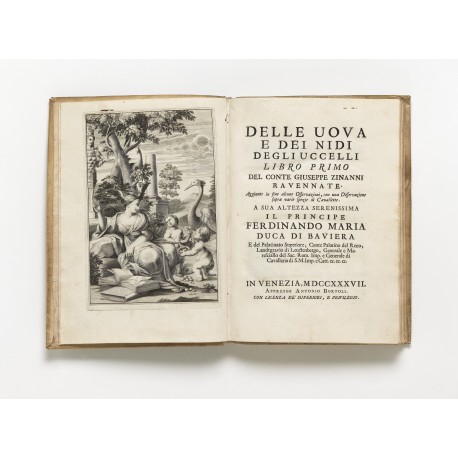Delle uova e dei nidi degli uccelli. Libro primo [all published] É Aggiunte in fine alcune Osservazioni, con una Dissertazione sopra varie spezie di Cavallette
- Subjects
- Book illustration - Artists, Italian - Barbiani (Andrea), 1708/1709-1779
- Book illustration - Artists, Italian - Pomarede (Silvester), active 1736-1768
- Cabinets of curiosities - Early works to 1800
- Eggs, Bird - Catalogues and collections - Early works to 1800
- Science books - Ornithology - Early works to 1800
- Authors/Creators
- Ginanni, Giuseppe, 1692-1753
- Artists/Illustrators
- Barbiani, Andrea, 1708/1709-1779
- Pomarede, Silvester, active 1736-1768
- Printers/Publishers
- Bortoli, Antonio, active 1689-1773
Ginanni, Giuseppe
Ravenna 1692 – 1753 Ravenna
Delle uova e dei nidi degli uccelli. Libro primo [all published]. Aggiunte in fine alcune Osservazioni, con una Dissertazione sopra varie spezie di Cavallette.
Venice, Antonio Bortoli, 1737
quarto, (100) ff. signed A–Z4 Aa–Bb4 (blank Bb4) and paginated (10) 1–130, (2) 1–55 (3), with engraved frontispiece (included in the registration), three engraved sub-titles, twenty-two plates (of eggs), and eight plates of grasshoppers, by Silvester Pomarede after designs of Andrea Barbiani.
provenance Sotheby’s, ‘Books and Maps’, London, 30 October 1989, lot 592 — Private Collection, Amsterdam
Wormtrack in margin of initial quire, otherwise in fine state of preservation.
binding contemporary Italian vellum.
First edition of ‘the first work to deal exclusively with birds’ eggs and birds’ nests’ (Anker), illustrating the eggs of one hundred species, classified (following Aldrovandi’s model) into three groups: predatory and non-predatory land birds, and aquatic birds, each with a brief account of the nest, breeding time, and physical features of the eggs. The appended treatise, ‘Osservazioni giornali sopra le Cavallette’, was the product of more than two years study, and features eight engraved plates of grasshoppers. The book earned for its author an international reputation.1
Ginanni created on his property in Ravenna a garden rich in exotic plants, a library of books on natural history, and a ‘piccolo Museo di cose naturali’, containing many of the specimens here engraved.2 The continuation promised on the title-page never appeared, for the reason (published in the dedication of the author’s Opere postume 1755) that ‘non essendomi riuscito di fare altra sufficiente Raccolta di Uova d’Uccelli’.3
Many interesting details about the genesis of the work and its publication are embedded in correspondence between the author and the naturalist Giovanni Bianchi (Iano Planco, 1693–1775) of Rimini.4 The book was conceived in January 1735 as ‘un piccolo tometto’ with illustrations after drawings to be supplied by ‘Sig. Andrea Barbiani [1708–1779] Pitore buono di Ravenna’. Initially, Ginanni considered Florentine and Venetian printmakers, but advised by a relative, he searched in Rome, and by the end of March 1735 had engaged there ‘Silvestro Pomarede [fl. 1736–1768] Franzese’. The programme for the frontispiece was decided immediately;5 however work on the plates proceeded slowly: the first two matrices were completed in September 1735, and the last was delivered at the beginning of March 1736. Difficulties meanwhile had arisen about the licensing of the book and the place of printing was quickly shifted, from Rome to Venice.
references Hermann August Hagen, Bibliotheca entomologica. Die Litteratur über das ganze Gebiet der Entomologie (Leipzig 1862), p.304 no. 1; Walther Horn, Index Litteraturae Entomologicae. Seria 1, Die Welt-Literatur über die gesamte Entomologie bis inklusive 1863 (Berlin 1928), no. 24867; Casey Wood, Introduction to the literature of vertebrate zoology (London 1931), no. 359; Jean Anker, Bird books and bird art (Copenhagen 1938), p.22 and no. 161; Giuseppe Morazzoni, Il Libro illustrato veneziano del settecento (Milan 1943), p.233; Claus Nissen, Die illustrierten Vogelbücher (Stuttgart 1953), p.42 and no. 1031; Bartolomeo Gamba, Serie dei testi di lingua e di altre opere importanti nella italiana letteratura scritte dal secolo xiv al xix (reprint Bologna 1982), no. 2265; Adriano Ceresoli, Bibliografia delle opere italiane latine e greche su la caccia, la pesca e la cinologia (Bologna 1969), p.559 (title-page reproduced); Rita Giudici, Fonti per la storia dell’agricoltura italiana dalla fine del xv alla metà del xviii secolo: saggio bibliografico (Milan 1995), p.104 no. 874
1. G. Ongaro, ‘Ginanni (Zinanni), Giuseppe’ in Dizionario biografico degli italiani 55 (Rome 2000), pp.5–7; Franco Gàbici, Scienziati di Romagna (Milan 2006), pp.91–95.
2. The collection was bequeathed with a life interest to Giuseppe’s two nephews and in perpetuity to his alma mater, the Jesuit Collegio dei Nobili di Ravenna; see Francesco Ginanni, Produzioni naturali che si ritrovano nel Museo Ginanni in Ravenna, metodicamente disposte e con annotazioni illustrate (Lucca 1762).
3. ‘Al Signor Marchese Scipione Maffei. Giuseppe Ginanni’, Opere postume del Conte Giuseppe Ginanni (Venice 1755), folio π2 verso; Paola Delbianco, in Le belle forme della natura: la pittura di Bartolomeo Bimbi (1648–1730) tra scienza e ‘maraviglia’, catalogue of an exhibition held at the Biblioteca Malatestiana, Cesena, edited by Daniela Savoia and Maria Letizia Strocchi (Modena 2001), pp.147–148.
4. Seventy-eight letters (dated 1730–1752) are in the Fondo Gambetti, Biblioteca Civica Gambalunga, Rimini; excerpts are published by Antonio Montanari, ‘Giuseppe di Prospero Zinanni accademico dei Lincei planchiani’ in Ravenna, studi e ricerche [Società di studi ravennati] 8 (2001), pp.109–128 (http://digilander.libero.it/monari/spec/ginanni.681.html; link).
5. ‘Il frontespizio consiste poi parte in boschereccia, e che vi siano monti, e valle, che verrà ad essere come un paesino. In questo vi sarà una figura grande sedendo la quale rappresento la Investigazione, che va osservando delle uova, e nido, e lì vicino vi sarà un Amoretto, che ce la presenti; nella valle poi vi sarà qualche Uccello aquatico, e sopra li alberi di altra specie, come in terra, cioè in ogni luogo di quella specie, che ivi suole annidare, sopra al già detto crederei facesse buono una fascia nella quale vi fosse scritto il seguente motto ricavato da Vergilio Felix qui potuit verum cognoscere causas’ (letter of 25 March 1735, transcribed by Montanari, op. cit., p.116).






